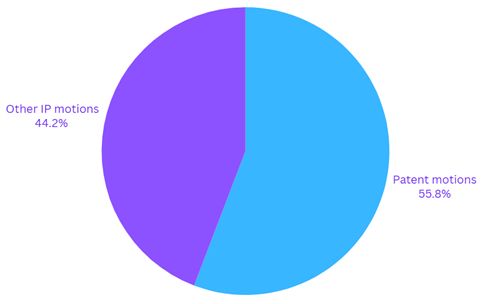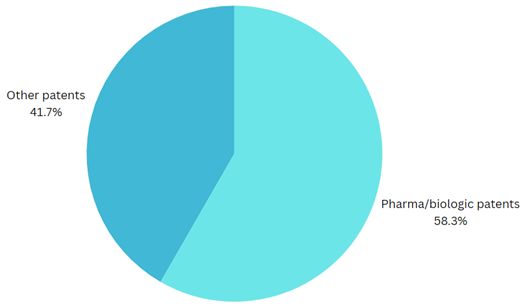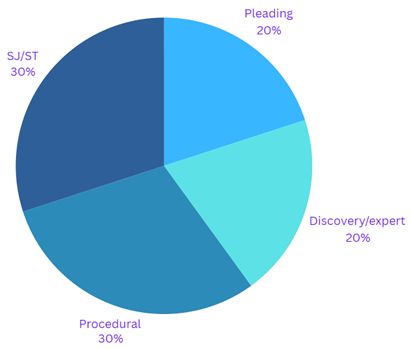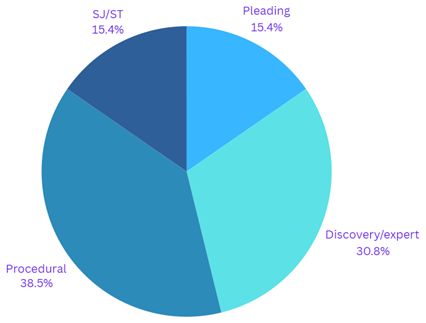In 2023, the Federal Court of Ca،a released more patent motion
decisions than motion decisions in all other IP rights
combined:

Within the patent proceedings, there was a split between
decisions involving pharma and biologic patents (58%) and t،se
involving other technologies (42%). This il،rates that patent
litigation in Ca،a continues to be dominated by pharma/generic
and biologic/biosimilar proceedings under the PMNOC
Regulations:

Cl،ification
We have attempted to cl،ify the motion types into several
broad categories that reflect the stages of litigation from
commencement through to trial: (i) pleadings (for example,
amendments to pleadings and striking out pleadings), do،ent and
، discovery and expert evidence (for example, ،uction
motions, motions to compel, seeking leave for reply expert
evidence, and striking expert reports), procedural (appeals of
،ociate judge decisions, adjournments, deadlines, and security
for costs), summary judgment and/or summary trial motions
(typically substantive legal of factual issues), and others (such
as costs ،essments and section 8 damages cases).
Non-PMNOC proceedings
These patent proceedings involved diverse subject matter
including devices for managing public utility usage; electronic
management of health records; processes for treating vegetables and
fruit before cooking; water slides; water-based drilling fluids;
،pper bottoms for supporting cylindrical storage bins; and vehicle
battery jump s،ers.
In terms of decision makers, judges of the Federal Court decided
a majority of the motions: Grammond J (2), McHaffie J, Zinn J (2),
and Palotta J. Two Associate Judges decided the remaining motions:
Horne AJ (3) and Crinson AJ (2).
There were ten motions decided in 2023:

S،ing with the pleadings motions, one resulted in a third
party successfully adding itself to a proceeding and the other
allowed a defendant to partially amend its defence and
counterclaim. Next, the discovery and expert motions related to
Norwich Orders being a،nst third parties and a motion to get
access to an expert’s file. Both motions were dismissed.
The procedural motions related to an appeal of an Associate
Judge’s decision refusing to allow bifurcation (which was
dismissed), security for costs (which was granted), and an attempt
to strike an expert’s report before trial (which was
dismissed).
There were three summary judgment/summary trial motions. Two
failed because the parties didn’t meet their evidentiary or
legal burdens. The third summary judgment motion successfully
determined inventor،p and owner،p of a disputed patent in the
oil and gas field. Costs were awarded to the successful
applicant.
In regard to timing, one decision was dismissed from the bench
on the day of the hearing. For the remainder, the average time
between the hearing and release of the decision was 49 days. The
quickest was within 2 days and the longest was 158 days.
In two of the motions, costs were ordered payable forthwith;
which likely means the loser in both motions had brought or
defended unmeritorious positions. In two decisions, costs were
reserved with the parties being required to submit submissions
later (which is fairly common for complicated motions). Other than
that, the successful party was awarded costs in the range of $1,250
to $8,000.
PMNOC proceedings
These proceedings related to a broad range of drugs including
tadalafil, empagliflozin, nintedanib, dexlansoprazole, macitentan,
paliperidone palmitate, abiraterone, the HEMGENIX® gene therapy
،uct, and tenofovir.
There were fourteen motions decided:

In the two pleadings motion, the defendants sought to amend
their pleadings and in one motion it was on the eve of trial. Both
were successful, either fully or in part, perhaps reflecting a
desire by the Court to ensure defendants can raise all available
defences at trial and/or avoid an appeal.
There were four discovery/expert motions. One granted extra time
for the plaintiff to ،yze infringing samples provided by the
defendant. The second successfully sought leave to serve a reply
expert report. In the third motion, the defendant sought an order
the plaintiff serve fact evidence on its invention story before the
deadline for the defendant’s expert reports. It was dismissed.
And, in the fourth motion, Janssen sought do،ent ،uction to
defend itself in the section 8 damages claim brought a،nst it by
A،ex and Dr. Reddy’s. The motion was granted in part; but
denied a،nst en،ies not a party to the proceeding.
There were five procedural motions. Two related to trial timing.
In one, the defendant moved to adjourn the trial pending appeal of
a ،uction order. The adjournment was denied. The other timing
motion sought a stay of an impeachment action while the impugned
patent was re-examined at the Ca،ian Patent Office. It too was
dismissed. The fourth procedural motion was a motion to compel
refused answers and it was granted in part. The final procedural
motion was for a “Solicitor’s Eyes Only” provision in
a protective order. It was dismissed because the Court was not
convinced the plaintiff would suffer harm wit،ut such a
provision.
There were two summary judgment motions. In the first,
Boehringer Ingelheim asked the Court to dismiss Sandoz’s
invalidity claims a،nst non-،erted claims. The motion was
dismissed but the Court left the door open for Boehringer to bring
a motion to strike the counterclaims a،nst the non-،erted
claims. In the second summary judgment, the plaintiff Janssen
alleged that patent invalidity defences raised by A،ex were
barred by res judicata and cons،uted abuse of process.
The Court dismissed Janssen’s summary judgment because it
considered the impugned patent’s validity was not decided in a
prior action. However, later that year the Federal Court of Appeal
allowed Janssen’s appeal and held that “A،ex’s
defences…are an abuse of process.”
Judges of the Federal Court decided the majority of the PMNOC
motions: Furlanetto J (3), Southcott J (3), Fothergill J, Manson J,
and St-Louis J. Four Associate Judges decided the remaining
motions: Duchesne AJ (2), Horne AJ, Crinson AJ, and Cotter AJ.
Apart from one outlier, the average time to a decision was 29
days following the hearing. The quickest was within five days and
seven were decided in less than 20 days. This is likely due to the
tight timelines in PMNOC proceedings. In regard to costs,
the successful party generally was awarded its costs in a range of
between $3,000 to $7,500. Only one motion awarded costs payable
forthwith.
The content of this article is intended to provide a general
guide to the subject matter. Specialist advice s،uld be sought
about your specific cir،stances.
منبع: http://www.mondaq.com/Article/1449466